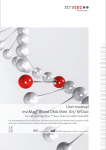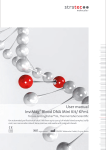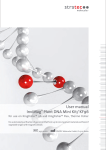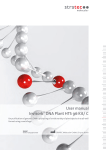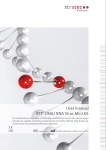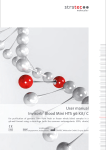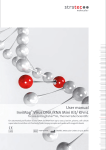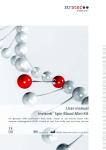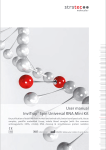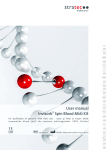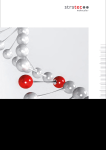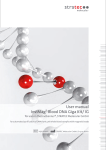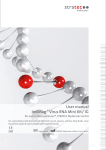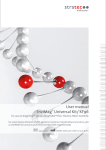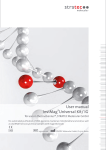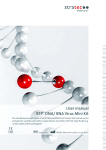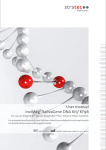Download InviMag Virus RNA Mini Kit User manual
Transcript
User manual ® InviMag Virus RNA Mini Kit optimized for the InviMag® Rack for purification of viral RNA from 200 µl serum, plasma, cell-free body fluids, rinse liquid from swabs, stool samples or small tissue sample with magnetic beads IVD REF 1440300x00 STRATEC Molecular GmbH, D-13125 Berlin Instruction for InviMag® Virus RNA Mini Kit The InviMag® Virus RNA Mini Kit combines the advantages of the innovative Invisorb® technology with easy handling of magnetic particles for a very efficient and reliable isolation of nucleic acids with a high purity. The RNA-binding magnetic particles are characterized by a high surface area, a uniform size distribution, and good suspension stability and are therefore highly suitable for high throughput processing. The InviMag® Virus RNA Mini Kit is suitable for isolation and purification of viral RNA from fresh or frozen plasma, serum, cell-free body fluids as well as rinsed liquid from swabs, stool samples or small tissue samples. The interplay of the RNA extraction and purification chemistry provided by the InviMag® Virus RNA Mini Kit with the InviMag® Rack was intensely tested and validated. Due to the high purity, the isolated RNA is ready to use for in vitro diagnostic analysis and for a broad panel of downstream applications or can be stored at – 80°C for subsequent use. The kit is neither suitable for isolation of viral DNA, bacteria, fungi or plants nor for purification of total RNA. IVD Compliance with EU Directive 98/79/EC on in vitro medical devices. Not for in vitro diagnostic use in countries where the EU Directive 98/79/EC on in vitro medical devices is not recognized. ® ® Trademarks: InviMag , Invisorb . Registered marks, trademarks, etc. used in this document, even when not specifically marked as such, are not to be considered unprotected by law. ® The Invisorb technology is covered by patents and patent applications: US 6,110363, US 6,043,354, US 6,037,465, EP 0880535, WO 9728171, WO 9534569, EP 0765335, DE 19506887, DE 10041825.2, WO 0034463. ® ® InviMag and Invisorb are registered trademarks of STRATEC Biomedical AG. The PCR process is covered by US Patents 4,683,195, and 4,683,202 and foreign equivalents owned by Hoffmann-La Roche AG. © 2013 STRATEC Molecular, all rights reserved. ® 1 InviMag Virus RNA Mini Kit 0113 Content Kit contents of InviMag® Virus RNA Mini Kit 3 Symbols 4 Storage 4 Quality control 4 Intended use 5 Product use limitation 5 Safety information 6 Product characteristic of the InviMag® Virus RNA Mini Kit 7 Sampling and storage of starting material 8 Principle and procedure 8 Yield and quality of viral RNA 9 Important notes 9 Important points before starting a protocol 9 Internal control (IC) / Extraction control 9 Reagents and equipment to be supplied by user 10 Scheme 11 Protocol 1: Isolation of viral RNA from cell-free body fluids (serum, plasma, CSF, synovia, urine) and from cell culture supernatant (cell culture media) 12 Protocol 2: Isolation of viral RNA from swabs or 200 µl rinse liquid 13 Protocol 3: Isolation of viral RNA from tissue biopsy 14 Protocol 4: Isolation of viral RNA from stool samples 15 Troubleshooting 16 Appendix 17 General notes on handling RNA 17 Ordering information 18 ® 2 InviMag Virus RNA Mini Kit 0113 Kit contents of InviMag® Virus RNA Mini Kit Store the MAP Solution A at 4 °C. Store lyophilized Carrier RNA 2 – 8 °C. Store dissolved Proteinase K at –20°C and dissolved Carrier RNA at –80°C! Store all other kit components at room temperature (RT)! 10 extractions 50 extractions 250 extractions 1440300900 1440300200 1440300300 7 ml 35 ml 160 ml 5 x 1 ml (ready to use) empty bottle (final volume 30 ml) empty bottle (final volume 120 ml) Proteinase K 250 µl 1.1 ml 3 x 2 ml Carrier RNA 240 µl 1.2 ml 3 x 2 ml 2 ml 2 ml 3 x 2 ml MAP Solution A 250 µl 1.1 ml 5 x 1.1 ml Wash Buffer R1 15 ml (ready to use) 30 ml (final volume 60 ml) 125 ml (final volume 250 ml) 2 x 15 ml (ready to use) 2 x 12 ml (final volume 2 x 60 ml) 2 x 50 ml (final volume 2 x 250 ml) 2 ml 15 ml 30 ml 2.0 ml Receiver Tube 10 50 5 x 50 1.5 ml Elution Tube 10 50 5 x 50 Manual 1 1 1 Catalogue No. Lysis Buffer RV Binding Solution (fill with 98-100% Isopropanol) RNase Free Water Wash Buffer R2 Elution Buffer R Initial steps Add of 250 µl of ddH2O to Proteinase K, mix thoroughly, store at – 20°C Add of 1.1 ml of ddH2O to Proteinase K, mix thoroughly, store at – 20°C Add of 2 ml of ddH2O to each vial Proteinase K, mix thoroughly, store at – 20°C Dilute Carrier RNA by Fill 30 ml Isopropanol addition of 240 µl RNase (molecular biologic Free Water grade) into the empty bottle Wash Buffer R1 is ready to use Dilute Carrier RNA by addition of 1.2 ml RNase Wash Buffer R2 is Free Water ready to use Fill 120 ml Isopropanol (molecular biologic grade) into the empty bottle Add 30 ml of 96 - 100 % ethanol to the bottle Wash Buffer R1. Add 125 ml of 96 - 100 % ethanol to the bottle Wash Buffer R1. Add 48 ml of 96 - 100 % ethanol to the bottle Wash Buffer R2. Add 200 ml of 96 - 100 % ethanol to each bottle Wash Buffer R2. Mix thoroughly and always keep the bottles firmly closed! Mix thoroughly and always keep the bottles firmly closed! Binding Solution is ready to use Dilute Carrier RNA by addition of 2 ml RNase Free Water to each vial ® 3 InviMag Virus RNA Mini Kit 0113 Symbols Manufacturer Lot number Catalogue number Date of manufacture Expiry date Consult operating instructions Temperature limitation Do not reuse Storage All buffers and kit contents of the InviMag® Virus RNA Mini Kit, except MAP Solution A, are stable for at least 12 months. MAP Solution A is stable for at least 6 months. All buffers and kit contents of the InviMag® Virus RNA Mini Kit, except Carrier RNA, dissolved Proteinase K and MAP Solution A, should be stored at room temperature (RT) Proteinase K: Dissolved Proteinase K must be stored at –20 °C. Dividing the Proteinase K into aliquots and storage at –20 °C is recommended. MAP Solution A should be stored at 4 °C. Carrier RNA: Lyophilized Carrier RNA can be stored at 2 - 8°C or at RT, but the recommendation for long time storage is –20°C. Dissolved Carrier RNA must be stored at -80°C, but repeated freezing and thawing will degrade the Carrier RNA and reduce the functionality of the kit. Therefore dividing Carrier RNA into aliquots and storage at –80°C is recommended. Wash Buffer: Wash Buffer charged with ethanol should be stored at room temperature and should be appropriate sealed. If there are any precipitates within the provided solutions solve these precipitates by careful warming up to room temperature (up to 30 °C). Room temperature (RT) is defined as range from 15 - 30°C. Quality control and product warranty STRATEC Molecular warrants the correct function of the InviMag® Virus RNA Mini Kit for applications as described in this manual. Purchaser must determine the suitability of the Product for its particular use. Should any Product fail to perform the applications as described in the manual, STRATEC Molecular will check the lot and if STRATEC Molecular investigates a problem in the lot, STRATEC Molecular will replace the Product free of charge. STRATEC Molecular reserves the right to change, alter, or modify any Product to enhance its performance and design at any time. In accordance with STRATEC Molecular’s ISO 9001-2000 and ISO EN 13485 certified Quality Management System the performance of all components of the InviMag® Virus RNA Mini Kit have been tested separately against predetermined specifications routinely on lotto-lot to ensure consistent product quality. If you have any questions or problems regarding any aspects of InviMag® Virus RNA Mini Kit or other STRATEC Molecular products, please do not hesitate to contact us. A copy of STRATEC Molecular’s terms and conditions can be obtained upon request or are presented at the STRATEC Molecular webpage. ® 4 InviMag Virus RNA Mini Kit 0113 For technical support or further information please contact: from Germany: +49-(0)30-9489-2901/ 2910 from abroad: +49-(0)30-9489-2907 or contact your local distributor. Intended use The InviMag® Virus RNA Mini Kit is designed for extraction and purification of viral RNA samples using magnetic beads and the InviMag® Rack. The nucleic acid isolation protocol is suitable for preparation of viral RNA from fresh or frozen plasma, serum, cell-free body fluids as well as rinsed liquid from swabs, stool samples or small tissue samples. For reproducible and high yields appropriate sample storage is essential (see “Sampling and storage of the starting material”, page 9). Fresh or frozen plasma or serum from blood treated with EDTA or citrate, (not with heparin) from common blood collection systems can be used. All utilities (reagents and plastic ware) necessary for preparation of viral RNA are provided by the InviMag® Virus RNA Mini Kit in different package sizes. The procedure of the InviMag® Virus RNA Mini Kit is optimized for the isolation of viral RNA from up to 200 µl starting material. For samples of a smaller volume than 200 µl please adjust a total sample volume of 200 µl with 1 x PBS prior to the start of an isolation protocol. THE PRODUCT IS INDENTED FOR USE BY PROFESSIONAL USERS ONLY, SUCH AS TECHNICIANS, PHYSICIANS AND BIOLOGISTS TRAINED IN MOLECULAR BIOLOGICAL TECHNIQUES. It is designed to be used with any downstream application employing enzymatic amplification or other enzymatic modifications of RNA followed by signal detection or amplification. Any diagnostic results generated by using the sample preparation procedure in conjunction with any downstream diagnostic assay should be interpreted with regard to other clinical or laboratory findings. To minimize irregularities in diagnostic results, adequate controls for downstream applications should be used. The kit is in compliance with EU Directive 98/79/EC on in vitro medical devices. But it is not for in vitro diagnostic use in countries where the EU Directive 98/79/EC on in vitro medical devices is not recognized. Product use limitation The kit is neither validated for isolation of viral RNA from cultured or isolated cells, bacteria, or fungi nor for purification of RNA. The included chemicals are only useable once. Differing of starting material or flow trace may lead to inoperability; therefore neither a warranty nor guarantee in this case will be given, neither implied nor express. The user is responsible to validate the performance of the STRATEC Molecular Product for any particular use. STRATEC Molecular does not provide for validation of performance characteristics of the Product with respect to specific applications. STRATEC Molecular Products may be used e.g.in clinical diagnostic laboratory systems conditioned upon the complete diagnostic system of the laboratory the laboratory has been validated pursuant to CLIA’ 88 regulations in the U.S. or equivalents in other countries. All Products sold by STRATEC Molecular are subject to extensive quality control procedures (according to ISO 9001-2000 and ISO EN 13485) and are warranted to perform as described herein. Any problems, incidents or defects shall be reported to STRATEC Molecular immediately upon detection thereof. The chemicals and the plastic parts are for laboratory use only; they must be stored in the laboratory and must not be used for purposes other than intended. The Product with its contents is unfit for consumption. ® 5 InviMag Virus RNA Mini Kit 0113 Safety information When and while working with chemicals, always wear a suitable lab coat, disposable gloves, and protective goggles! Avoid skin contact! Adhere to the legal requirements for working with biological material! For more information, please consult the appropriate material safety data sheets (MSDS). These are available online in convenient and compact PDF format at www.stratec.com for each STRATEC Molecular Product and its components. If buffer bottles are damaged or leaking, WEAR GLOVES, AND PROTECTIVE GOGGLES when discarding the bottles in order to avoid any injuries. STRATEC Molecular has not tested the liquid waste generated by the InviMag® Virus RNA Mini Kit procedures for residual risk materials. Therefore, liquid waste has to be handled and discarded according to local safety regulations. European Community risk and safety phrases for the components of the InviMag® Virus RNA Mini Kit to which they apply, are listed below as follows: Lysis Buffer RV Proteinase K: warning H302-312-332-412 EUH032 P273 danger H315-319-334-335 P280-305-351-338-310-405 Wash Buffer R1 danger H302-312-332-412 EUH032 P273 H302: H312: H332: H412: H315: H319: H334: H335: EUH032: P273: P280: P305+P351+P338: P310: P405: Harmful if swallowed. Harmful in contact with skin. Harmful if inhaled. Harmful to aquatic life with long lasting effects. Causes skin irritation. Causes serious eye irritation. May cause allergy or asthma symptoms or breathing difficulties if inhaled. May cause respiratory irritation. Contact with acids liberates very toxic gas. Avoid release to the environment. Wear protective gloves/protective clothing/eye protection/face protection. IF IN EYES: Rinse cautiously with water for several minutes. Remove contact lenses, if present and easy to do. Continue rinsing. Immediately call a POISON CENTER or doctor/physician. Store locked up. Emergency medical information in English and German can be obtained 24 hours a day from infotrac: outside of USA: in USA : 1 – 352 – 323 – 3500 1 – 800 – 535 – 5053 ® 6 InviMag Virus RNA Mini Kit 0113 Product characteristic of the InviMag® Virus RNA Mini Kit The InviMag® Virus RNA Mini Kit procedure is the ideal tool for efficient extraction and purification of viral RNA from fresh or frozen plasma, serum, cell-free body fluids as well as rinsed liquid from swabs, stool samples or small tissue samples using magnetic beads and the InviMag® Magnetic Rack. Starting material up to 200 µl serum or plasma up to 200 µl cell free body fluids 200 µl rinse liquid from swab stool samples small tissue samples Time for preparation Yield depends on the sample (source and storage) about 70 min Note: The added Carrier RNA will account for most of the eluted RNA. Quantitative RTPCR is recommended for determination of the viral RNA yield. The RNA isolation process is based on the interaction of nucleic acids with coated magnetic particles under adapted buffer conditions. The volume of buffers and other liquids necessary for RNA isolation is reduced to a minimum. After a sample specific cell lysis in the optimized Lysis Buffer RV in the presence of Proteinase K and Carrier RNA the optimal binding conditions are adjusted by addition of Binding Solution. The viral RNA binds to the simultaneously added magnetic particles and is separated from the solution by the InviMag® Rack. Subsequent to the washing steps of the particle bound nucleic acids, the viral RNA is eluted in Elution Buffer R. Due to the high purity, the eluted viral RNA is ready to use for a broad panel of downstream applications: ż ż ż RT-PCR RT real-time PCR or array technologies The results from downstream applications should be interpreted with regard to other clinical or laboratory findings. To minimize irregularities in diagnostic results, adequate controls for downstream applications should be used. For the isolation of viral RNA from single samples STRATEC Molecular offers the Invisorb® Spin Virus RNA Mini Kit for use in a centrifuge (see “Ordering information”, page 18). For automated isolation of viral RNA is offering two further bead based versions, the InviMag® Virus RNA Mini Kit/ KFmL, the InviMag® Virus RNA Mini Kit/ KF96 and a vacuum based version the Invisorb® Virus RNA HTS 96 Kit for use on robotic stations, vacuum manifold and centrifuges. For further information please contact: Phone +49 (0) 30 9489 2901, 2910 in Germany and from foreign countries phone +49 (0) 30 9489 2907 or your local distributor. Sampling and storage of starting material Best results are obtained using freshly extracted samples. As long as the samples are not shock frosted with liquid nitrogen or are incubated with RNase inhibitors or denaturing reagents, the RNA is not secured. Therefore it is essential, that samples are immediately flash frozen subsequent to the harvesting by using liquid nitrogen and are stored at -80°C. RNA contained in such deep frozen samples is stable for months. RNA purification should be processed as soon as possible. Samples can also be stored in Lysis Buffer RV for 1 h at room temperature, overnight at 4°C, and for long term storage at –80°C. Storage under deep frozen conditions is recommended. ® 7 InviMag Virus RNA Mini Kit 0113 After collection and centrifugation, serum, plasma, from blood (treated with anticoagulants like EDTA or citrate, but not with heparin), synovial fluid samples or other cell-free body fluids, swabs as well as stool samples can be stored on ice for 1 - 2 hours, for short time (up to 24 h) samples may be stored at -20°C. For long term storage, we recommend freezing samples in aliquots at –80°C. Frozen plasma or serum samples must not be thawed more than once. Multiple thawing and freezing before isolating the viral RNA should be avoided. It leads to denaturation and precipitation of proteins, resulting in reduced viral titers and therefore reduced yields of viral nucleic acids. In addition, cryoprecipitates formed during freeze-thawing can give problems. If cryoprecipitates are visible, they should be pelleted by centrifugation at app. 6800 x g for 3 minutes. The cleared supernatant should be aspirated, without disturbing the pellet and processed immediately. This step will not reduce viral titers. Best results are obtained with fresh tissue material or material that has been immediately flash frozen and stored at –20°C or –80°C. Repeated freezing and thawing of stored samples should be avoided, since this leads to reduced RNA yield. Use of poor quality starting material influences the RNA yield, too. The thawing process could be proceed, e.g. directly in Lysis Buffer RV. Principle and procedure The InviMag® Virus RNA Mini Kit procedure comprises following steps: ż ż ż ż lysis of the virus particles in the Lysis Buffer RV binding the viral RNA to the magnetic beads washing and elimination of ethanol elution of viral RNA After lysis the viral RNA binds to the magnetic beads, contaminations and enzyme inhibitors are efficiently removed during the following three wash steps and highly purified RNA is eluted in Elution Buffer R. This manual contains 4 protocols (page 13-16). Lysis Samples are lysed under denaturing conditions at elevated temperatures in the presence of Lysis Buffer RV, Carrier RNA and Proteinase K in a 2,0 ml Receiver Tube. Processing a large number of samples the preparation of a master mixture of a volume 5% greater than that required for the processing of all samples is recommended. Mix the master mix carefully prior to use. Binding of the viral nucleic acids After adding Binding Solution and MAP Solution A to the lysate in the 2.0 ml Receiver Tube, the viral RNA is bound to the surface of the magnetic beads. Removing residual contaminants Contaminants are efficiently washed away using Wash Buffer R1 and R2, while the viral RNA remains bound to the magnetic beads. Elution The viral RNA is eluted from the beads using 200 µl Elution Buffer R. The eluted viral RNA is ready for use in different subsequent tests e. g. RNA dot blots, cDNA transcription, realtime PCR (quantitative RT-PCR, like TaqMan® und LightCycler® technologies) or array technologies. ® 8 InviMag Virus RNA Mini Kit 0113 Yield and quality of viral RNA Different amplification systems vary in efficiency depending on the total amount of nucleic acid present in the reaction. Eluates from this kit contain both viral RNA and Carrier RNA, and amounts of Carrier RNA will greatly exceed amounts of viral nucleic acids. Yields of viral RNA isolated from biological samples are normally less WKDQ ȝJ DQG WKHUHIRUHGLIILFXOWWRGHWHUPLQHSKRWRPHWULFDOO\.HHSLQPLQGWKDWWKH&DUULHU51$ȝJSHU ȝOVDPSOHZLOODFFRXQWIRUPRVWRIWKH51$SUHVHQW The kit is suitable for downstream analysis with NAT techniques, for examples qPCR, RT qPCR, LAMP, LCR. Diagnostic assays should be performed according to the manufacturer’s instructions. Quantitative RT-PCR is recommended for determination of viral RNA yield. * In Gel Electrophoresis and in Capillary Electrophoresis, RNA extracted with the provided kit looks like degraded cause the kit contains Carrier RNA, this is poly A RNA in fragments of 100 up to 1000 bases. The kit is not dedicated for applications using this kind of analysis. Important notes Important points before starting a protocol Immediately upon receipt of the Product, inspect the Product and its components as well as the package for any apparent damages, correct quantities and quality. If there are any unconformities you have to notify STRATEC Molecular in writing with immediate effect upon inspection thereof. If buffer bottles are damaged, contact the STRATEC Molecular Technical Services or your local distributor. In case of liquid spillage, refer to “Safety Information” (see page 6). Do not use damaged kit components, since their use may lead to poor kit performance. ż ż ż ż ż ż ż ż Always change pipet tips between liquid transfers. To avoid cross-contamination, we recommend the use of aerosol-barrier pipet tips. All centrifugation steps are carried out at room temperature. When working with chemicals, always wear a suitable lab coat, disposable gloves and protective goggles. Discard gloves if they become contaminated. Do not combine components of different kits, unless the lot numbers are identical. Avoid microbial contamination of the kit reagents. To minimize the risk of infections from potentially infectious material, we recommend working under laminar air-flow until the samples are lysed. This kit should only be used by trained personnel. Internal control (IC) / Extraction control Internal Controls (IC) from the PCR assay provider can be used as extraction controls if the fragments are longer than 100 bp. In this case they have to be added after finalization of the lysis step. Alternatively it can be mixed with the Carrier RNA. Attention: don´t add directly these Internal Controls to the sample! ® 9 InviMag Virus RNA Mini Kit 0113 Preparing reagents and buffers 10 viral RNA-extractions: Dilute Proteinase K by addition of 250 µl ddH2O, mix thoroughly and store like described below! Dilute Carrier RNA* by addition of 240 µl RNase Free Water. Binding Solution is ready to use Wash Buffer R1 is ready to use Wash Buffer R2 is ready to use Mix thoroughly and always keep the bottles firmly closed! 50 viral RNA-extractions: Fill 30 ml Isopropanol (molecular biologic grade) into the empty bottle Dilute Proteinase K by addition of 1.1 ml of ddH2O, mix thoroughly and store like described below! Dilute Carrier RNA* by addition of 1.2 ml RNase Free Water. Add 30 ml of 96 - 100 % ethanol to the bottle Wash Buffer R1. Add 48 ml of 96 - 100 % ethanol to the bottle Wash Buffer R2. Mix thoroughly and always keep the bottles firmly closed! 250 viral RNA-extractions: Fill 120 ml Isopropanol (molecular biologic grade) into the empty bottle Dilute each vial Proteinase K by addition of 2 ml of ddH2O, mix thoroughly and store like described below! Dilute each vial Carrier RNA* by addition of 2 ml RNase Free Water. Add 125 ml of 96 - 100 % ethanol to the bottle Wash Buffer R1. Add 200 ml of 96 - 100 % ethanol to each bottle Wash Buffer R2. Mix thoroughly and always keep the bottles firmly closed! * Dissolved Carrier RNA should be stored at -80°C, but repeated freezing and thawing will degrade the RNA and reduce the functionality of the Kit. Dividing Carrier RNA into aliquots is recommended. Reagents and equipment to be supplied by user ż ż ż ż ż ż ż Measuring cylinder (250 ml) Pipette and pipette tips Disposable gloves ddH2O Vortexer 96-100% ethanol Isopropanol* * Possible suppliers for Isopropanol: Carl Roth 2-Propanol Rotipuran >99.7%, p.a., ACS, ISO Order no. 6752 Applichem 2-Propanol, molecular biology grade Order no. A3928 Sigma 2-Propanol Order no. 59304-1L-F Carrier RNA Carrier RNA serves two purposes. Firstly, it enhances the binding of viral acids to the magnetic beads by saturation of non specific binding sites of the vials, especially if there are very few target molecules in the sample. Secondly, the addition of large amounts of Carrier RNA reduces the chance of viral RNA degradation in the rare event that RNase molecules are no denaturated by chaotropic salts and detergents in the Lysis Buffer RV. If Carrier RNA is not added to the Lysis Buffer RV, this may lead to reduced viral RNA recovery. ® 10 InviMag Virus RNA Mini Kit 0113 Scheme of the InviMag® Virus RNA Mini Kit Please read protocols prior the start of the preparation carefully Transfer the sample into the 2.0 ml Receiver Tube and add 600 µl Lysis Buffer RV, 20 µl Proteinase K and 20 µl Carrier RNA to the sample. Mix by pipetting 5 times Incubate under shaking for 10 minutes at 65°C. Add 400 µl Binding Solution and 20 µl MAP Solution A to the lysate, Mix by pipetting up and down 5 times ® Put the tube in the InviMag Rack Incubate for 5 min at RT Insert the Magnetic Stripe Incubate again for 5 min at RT Removal of lysed material by aspiration or pipetting Remove Magnetic Stripe Add 800 µl Wash Buffer R1, Close the vial and mix by vortexing Insert the Magnetic Stripe Incubate for 3 min at RT Removal of the Wash Buffer R1 eluate by aspiration or pipetting Remove Magnetic Stripe Add 800 µl Wash Buffer R2 (A) Close the vial and mix by vortexing Incubate for 3 min at RT Insert the Magnetic Stripe Incubate for 3 min at RT Removal of the Wash Buffer R2 eluate by aspiration or pipetting Remove Magnetic Stripe Repeat this step from point (A) Insert the Magnetic Stripe, open the lid Incubate for 10 min at RT to evaporate ethanol Remove Magnetic Stripe Add 100 µl Elution Buffer R Mix by vortexing Incubate for 5 min at RT Insert the Magnetic Stripe Incubate for 3 min at RT Transfer of the eluate with pure viral RNA in a 1.5 ml Elution Tube 11 ® InviMag Virus RNA Mini Kit 0113 Protocol 1: Isolation of viral RNA from cell-free body fluids (serum, plasma, CSF, synovia, urine) and from cell culture supernatant (cell culture media) Please read the instructions carefully and conduct the prepared procedure. 1. Transfer 200 µl of the sample (serum, plasma, CSF, synovia, urine, cell culture) into a 2.0 ml Receiver Tube and add 600 µl Lysis Buffer RV, 20 µl Proteinase K, and 20 µl Carrier RNA. Close the cap and mix for 10 s. 2. Place the 2.0 ml Receiver Tube into a thermomixer and incubate under continuously shaking for 10 minutes at 65°C. 3. Add 400 µl Binding Solution and 20 µl MAP Solution A and mix the sample pipetting up and down for 4- 5 times. Incubate the mixture for 5 min at RT under shaking. Note: Vortex the tube MAP Solution A vigorously before use! 4. Transfer the 2.0 ml Receiver Tube in the Magnetic Rack without magnet. Insert the Magnetic Stripe and incubate for further 5 min at RT. Remove supernatant by aspiration or by pipetting, then remove the Magnetic Stripe. 5. Add 800 µl Wash Buffer R1 to the vial. Close the vial, and mix it by vortexing. Incubate for 3 min in the Magnet Rack with inserted Magnetic Stripe. Remove supernatant, then remove the Magnetic Stripe. 6. Add 800 µl Wash Buffer R2 to the vial. Close the vial, and mix it by vortexing. Incubate for 3 min in the Magnet Rack with inserted Magnetic Stripe. Remove supernatant, then remove the Magnetic Stripe. Repeat once this Step. 7. Insert the Magnetic Stripe and open the lid of the tube for 10 min to evaporate the ethanol completely. 8. Remove the Magnetic Stripe, then add 100 µl of the Elution Buffer R, mix by vortexing or pipetting up and down for three times. Incubate at room temperature for 5 min. 9. Insert the Magnetic Stripe and incubate for further 3 min. Transfer the eluate to the 1,5 ml Elution Tube. It contains the viral nucleic acids ready to use. Note: The viral nucleic acids can also be eluted with a lower volume of Elution Buffer R (depends on the expected amounts of viral nucleic acids). But pay attention that minimum volume for the elution is 30 µl and that this volume can reduce the maximum yield. If quite large amount of viral nucleic acids are expected, the volume of Elution Buffer R can be increased. Important Notes: After finishing the extraction protocol, the Elution Tube contains the extracted viral RNA. We recommend storage of the RNA at –80°C. If the viral RNA contains carryover of magnetic particle, transfer the viral NA into a 1.5 ml reaction tube and centrifuge at maximum speed for 1 minute and pipette the viral RNA containing supernatant into a new tube. 12 ® InviMag Virus RNA Mini Kit 0113 Protocol 2: Isolation of viral RNA from swabs or 200 µl rinse liquid Please read the instructions carefully and conduct the prepared procedure 1a. Place the swab into the 2.0 ml Receiver Tube and add 200 µl of ddH2O. Close the cap and mix by vortexing for 10 s. Then add 600 µl Lysis Buffer RV, 20 µl Proteinase K, and 20 µl Carrier RNA. Close the cap and mix for 10 s. 1b. Transfer 200 µl of rinse liquid, or of the stabilization media into the 2.0 ml Receiver Tube. Then add 600 µl Lysis Buffer RV, 20 µl Proteinase K, and 20 µl Carrier RNA. Close the cap and mix by vortexing for 10 s. 2. Place the 2.0 ml Receiver Tube into a thermomixer and incubate under continuously shaking for 10 minutes at 65°C. We recommend breaking the swab and removing it after lysis. 3. Add 400 µl Binding Solution and 20 µL MAP Solution A and mix the sample pipetting up and down for 4 - 5 times. Incubate the mixture for 5 min at RT under shaking. Note: Vortex the tube MAP Solution A vigorously before use! 4. Transfer the 2.0 ml Receiver Tube in the Magnetic Rack without magnet and insert the Magnetic Stripe. Incubate for further 5 min at RT. Remove supernatant by aspiration or by pipetting, and then remove the Magnetic Stripe. 5. Add 800 µl Wash Buffer R1 to the vial. Close the vial, and mix it by vortexing. Incubate for 3 min in the Magnet Rack with inserted Magnetic Stripe. Remove supernatant, and then remove the Magnetic Stripe. 6. Add 800 µl Wash Buffer R2 to the vial. Close the vial, and mix it by vortexing. Incubate for 3 min in the Magnet Rack with inserted Magnetic Stripe. Remove supernatant, and then remove the Magnetic Stripe. Repeat once this Step. 7. Insert the Magnetic Stripe and open the lid of the tube for 10 min to evaporate the ethanol completely. 8. Remove the Magnetic Stripe, then add 100 µl of the Elution Buffer R, mix by vortexing or pipetting up and down for three times. Incubate at room temperature for 5 min. 9. Insert the Magnetic Stripe and incubate for further 3 min. Transfer the eluate to the 1,5 ml Elution Tube. It contains the viral nucleic acids ready to use. Note: The viral nucleic acids can also be eluted with a lower volume of Elution Buffer R (depends on the expected amounts of viral nucleic acids). But pay attention that minimum volume for the elution is 30 µl and that this volume can reduce the maximum yield. If quite large amount of viral nucleic acids are expected, the volume of Elution Buffer R can be increased. Important Note: To get maximum yield of viral nucleic acids it is essential to leave the swab during the complete lysis time into the reaction tube. It is possible to cut the shaft of the swab, so that you can close the cap of the Tube. It is also possible to do the lysis step with opened cap. The removing of the swab from Tube ahead of time will be lead to a dramatically reduced final yield! After lysis time carefully squeeze out the swab on the wall of the tube and discard the swab. Important Notes: After finishing the extraction protocol, the Elution Tube contains the extracted viral RNA. We recommend storage of the RNA at –80°C. If the viral RNA contains carryover of magnetic particle, transfer the viral NA into a 1.5 ml reaction tube and centrifuge at maximum speed for 1 minute and pipette the viral RNA containing supernatant into a new tube. 13 ® InviMag Virus RNA Mini Kit 0113 Protocol 3: Isolation of viral RNA from tissue biopsy Please read the instructions carefully and conduct the prepared procedure 1. Transfer 1 mg up to – max. 10 mg of the tissue biopsy into the 2.0 ml Receiver Tube. Add 200 µl of ddH2O. Then add 600 µl Lysis Buffer RV, 20 µl Proteinase K, and 20 µl Carrier RNA. 2. Place the 2.0 ml Receiver Tube into a thermomixer and incubate under continuously shaking for 10 minutes at 65°C. 3. Add 400 µl Binding Solution and 20 µL MAP Solution A and mix the sample pipetting up and down for 4- 5 times. Incubate the mixture for 5 min at RT under shaking. Note: Vortex the tube MAP Solution A vigorously before use! 4. Transfer the 2.0 ml Receiver Tube in the Magnetic Rack without magnet and insert the Magnetic Stripe. Incubate for further 5 min at RT. Remove supernatant by aspiration or by pipetting, and then remove the Magnetic Stripe. 5. Add 800 µl Wash Buffer R1 to the vial. Close the vial, and mix it by vortexing. Incubate for 3 min in the Magnet Rack with inserted Magnetic Stripe. Remove supernatant,and then remove the Magnetic Stripe. 6. Add 800 µl Wash Buffer R2 to the vial. Close the vial, and mix it by vortexing. Incubate for 3 min in the Magnet Rack with inserted Magnetic Stripe. Remove supernatant, and then remove the Magnetic Stripe. Repeat once this Step. 7. Insert the Magnetic Stripe and open the lid of the tube for 10 min to evaporate the ethanol completely. 8. Remove the Magnetic Stripe, then add 100 µl of the Elution Buffer R, mix by vortexing or pipetting up and down for three times. Incubate at room temperature for 5 min. 9. Insert the Magnetic Stripe and incubate for further 3 min. Transfer the eluate to the 1,5 ml Elution Tube. It contains the viral nucleic acids ready to use. Note: The viral nucleic acids can also be eluted with a lower volume of Elution Buffer R (depends on the expected amounts of viral nucleic acids). But pay attention that minimum volume for the elution is 30 µl and that this volume can reduce the maximum yield. If quite large amount of viral nucleic acids are expected, the volume of Elution Buffer R can be increased. Important Notes: After finishing the extraction protocol, the Elution Tube contains the extracted viral RNA. We recommend storage of the RNA at –80°C. If the viral RNA contains carryover of magnetic particle, transfer the viral NA into a 1.5 ml reaction tube and centrifuge at maximum speed for 1 minute and pipette the viral RNA containing supernatant into a new tube. 14 ® InviMag Virus RNA Mini Kit 0113 Protocol 4: Isolation of viral RNA from stool samples Please read the instructions carefully and conduct the prepared procedure 1. Pipet 400 µl ddH2O in 1.5 ml reaction tube (not provided). Add a glass stick to the stool sample and transfer the adherent sample (size of a lentil) in the prefilled 1.5 ml reaction tube. Resuspend the sample in the prefilled water. Close the tube and vortex each sample vigorously until it becomes a homogenic suspension. 2. Centrifuge the samples for 5 min at 240 x g (15000 rpm) (e.g. Hettich Universal 30 RF). Please dip carefully the pipette tip about 0.5 mm below the surface and take from there 200 µl supernatant (prevent the aspiration of swimming particles) and transfer the sample in a 2.0 ml Receiver Tube. 3. Add 600 µl Lysis Buffer RV, 20 µl Proteinase K, and 20 µl Carrier RNA. 4. Place the 2.0 ml Receiver Tube into a thermomixer and incubate under continuously shaking for 10 minutes at 65°C. 5. Add 400 µl Binding Solution and 20 µL MAP Solution A and mix the sample pipetting up and down for 4- 5 times. Incubate the mixture for 5 min at RT under shaking. Note: Vortex the tube MAP Solution A vigorously before use! 6. Transfer the 2.0 ml Receiver Tube in the Magnetic Rack without magnet and insert the Magnetic Stripe. Incubate for further 5 min at RT. Remove supernatant by aspiration or by pipetting, and then remove the Magnetic Stripe. 7. Add 800 µl Wash Buffer R1 to the vial. Close the vial, and mix it by vortexing. Incubate for 3 min in the Magnet Rack with inserted Magnetic Stripe. Remove supernatant, and then remove the Magnetic Stripe. 8. Add 800 µl Wash Buffer R2 to the vial. Close the vial, and mix it by vortexing. Incubate for 3 min in the Magnet Rack with inserted Magnetic Stripe. Remove supernatant, and then remove the Magnetic Stripe. Repeat once this Step. 9. Insert the Magnetic Stripe and open the lid of the tube for 10 min to evaporate the ethanol completely. 10. Remove the Magnetic Stripe, then add 100 µl of the Elution Buffer R, mix by vortexing or pipetting up and down for three times. Incubate at room temperature for 5 min. 11. Insert the Magnetic Stripe and incubate for further 3 min. Transfer the eluate to the 1.5 ml Elution Tube. It contains the viral nucleic acids ready to use. Note: The viral nucleic acids can also be eluted with a lower volume of Elution Buffer R (depends on the expected amounts of viral nucleic acids). But pay attention that minimum volume for the elution is 30 µl and that this volume can reduce the maximum yield. If quite large amount of viral nucleic acids are expected, the volume of Elution Buffer R can be increased. Important Notes: After finishing the extraction protocol, the Elution Tube contains the extracted viral RNA. We recommend storage of the RNA at –80°C. If the viral RNA contains carryover of magnetic particle, transfer the viral NA into a 1.5 ml reaction tube and centrifuge at maximum speed for 1 minute and pipette the viral RNA containing supernatant into a new tube. 15 ® InviMag Virus RNA Mini Kit 0113 Troubleshooting Problem Probable cause Comments and suggestions low amount of extracted RNA insufficient lysis increase lysis time, but prevent too long lysis time because this also decrease yield reduce amount of starting material incomplete elution take higher volume of Elution Buffer R, be sure you pipet the Elution Buffer R with the right amount to the right position low amount of MAP Solution A mix MAP Solution A thoroughly before pipeting to the Deep Well Plate too much Elution Buffer elute the RNA with lower volume of Elution Buffer R incorrect storage of starting material ensure that the storage of starting material was correctly avoid repeated thawing of the material incorrect Wash Buffers make sure that the correct amount of ethanol is added to the Wash Buffers and that they are stored correctly incorrect storage of starting material ensure that the storage of starting material was correct avoid thawing of the material old material ensure that the starting material is fresh or stored under appropriate conditions (for long time storage at -80 °C) avoid thawing and freezing of the material RNA does not perform well in downstreamapplications (e.g. RT qPCR) ethanol carryover during elution increase drying time for removing of ethanol salt carryover during elution check up the Wash Buffers for salt precipitates. If there are any precipitates, solve these precipitates by careful warming ensure that the Wash Buffers are at room temperature low A260:A280 ratio from UV measurement, eluted RNA is brown colored small part of the magnetic particles are left in the elution centrifuge down at full speed for 1 min and transfer supernatant to a new tube low concentration of extracted RNA degraded RNA 16 ® InviMag Virus RNA Mini Kit 0113 Appendix General notes on handling RNA RNA is far less stable than DNA. It is very sensitive to degradation by endogenous RNases in the biological material and exogenous RNases, which are permanently present everywhere in the lab. To achieve satisfactory qualitative and quantitative results in RNA preparations, contamination with exogenous RNases has to be reduced as much as possible. Avoid handling bacterial cultures, cell cultures or other biological sources of RNases in the same lab where the RNA purification is to be carried out. Electrophoresis tanks should be cleaned with detergent solution (e.g. 0.5% SDS), thoroughly rinsed with RNase free water, and then rinsed with ethanol and allowed to dry. Non-disposable plastic ware should be treated before use to ensure that it is RNase free. Plastic ware should be thoroughly rinsed with 0.1M NaOH, 1mM EDTA followed by RNase free water. You can also take chloroform-resistant plastic ware rinsed with chloroform to inactivate RNases. All buffers must be prepared from DEPC-treated RNase free ddH2O. Change gloves frequently and keep tubes closed. Reduce the preparation time as much as possible. Keep isolated RNA on ice. Do not use kit components from other kits with the kit you are currently using, unless the lot numbers are identical. To minimize the risk of infections from potentially infectious material, we recommend working under laminar air-flow until the samples are lysed. This kit should only be used by personnel trained in in vitro diagnostic laboratory practice. 17 ® InviMag Virus RNA Mini Kit 0113 Ordering information Product Package size Catalogue No. ® 10 preparations 1440300900 ® 50 preparations 1440300200 ® 250 preparations 1440300300 ® 1 x 96 preparations 7443300100 ® 5 x 96 preparations 7443300200 ® 1 x 96 preparations 7442300100 ® 5 x 96 preparations 7442300200 InviMag Virus RNA Mini Kit InviMag Virus RNA Mini Kit InviMag Virus RNA Mini Kit Related Products InviMag Virus RNA Kit/ KF96 InviMag Virus RNA Kit/ KF96 InviMag Virus DNA Kit/ KF96 InviMag Virus DNA Kit/ KF96 ® 15 preparations 2442110100 ® 75 preparations 2442110200 ® 15 preparations 2443110100 ® 75 preparations 2443110200 ® 50 preparations 1040300200 ® 250 preparations 1040300300 ® 50 preparations 1040200200 ® 250 preparations 1040200300 InviMag Virus DNA Kit/ KFmL InviMag Virus DNA Kit/ KFmL InviMag Virus RNA Kit/ KFmL InviMag Virus RNA Kit/ KFmL Invisorb Spin Virus RNA Mini Kit Invisorb Spin Virus RNA Mini Kit Invisorb Spin Virus DNA Mini Kit Invisorb Spin Virus DNA Mini Kit ® InviMag Rack 1 piece 5010320000 Possible suppliers for Isopropanol: Carl Roth Applichem Sigma 2-Propanol Rotipuran >99.7%, p.a., ACS, ISO Order no. 6752 2-Propanol, molecular biology grade Order no. A3928 2-Propanol Order no. 59304-1L-F 18 ® InviMag Virus RNA Mini Kit 0113 STRATEC Molecular GmbH Robert-Rössle-Str. 10 13125 Berlin, Germany www.stratec.com 1G5j03/01/2013 Phone: +49 30 94 89 29 01 Fax: +49 30 94 89 29 09 E-mail: [email protected]





















